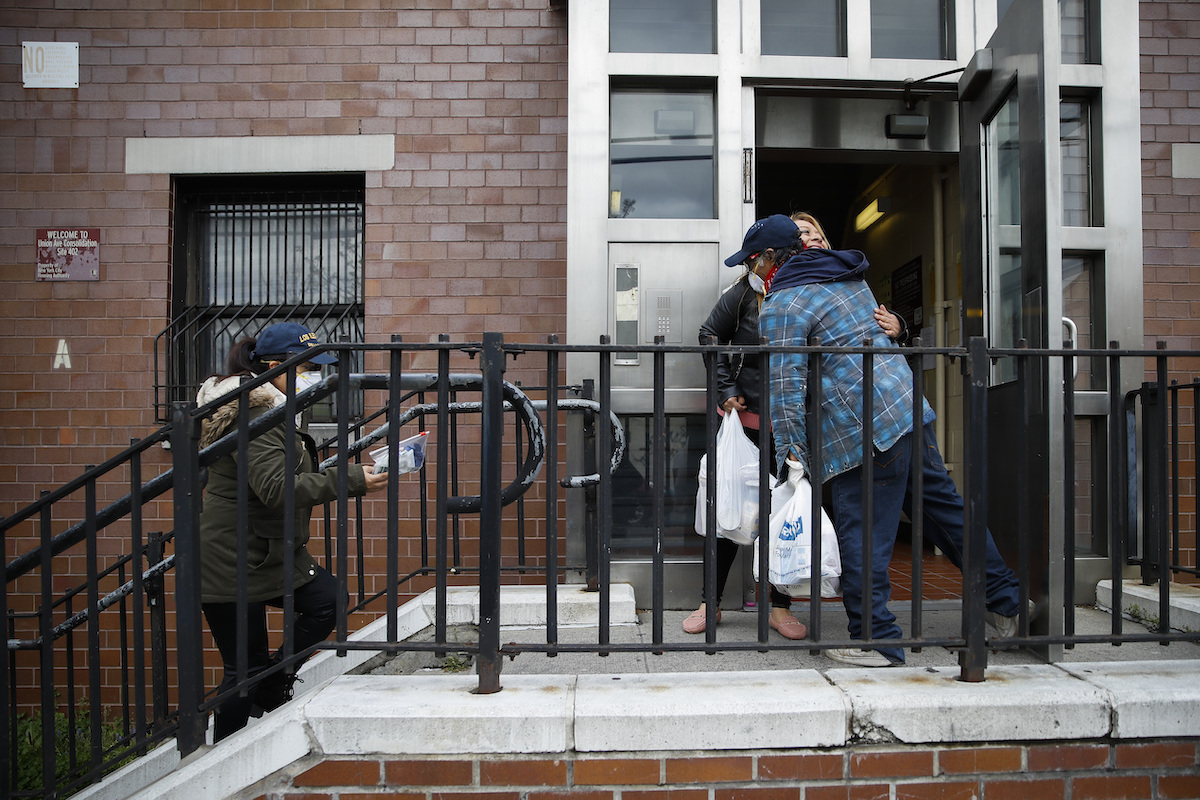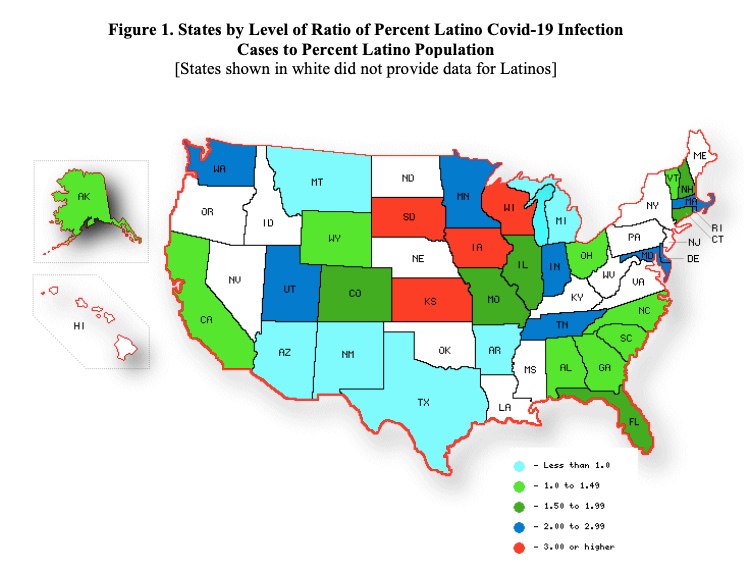

Francisco Ramírez, right, receives a hug from a donation provider, center, as Sandra Pérez offers a bag of supplies to her, Saturday, April 18, 2020, in the Bronx borough of New York. (AP Photo/John Minchillo)
There is much need for information concerning the impact of the COVID-19 on the Latino community. Over the last month, we have heard growing worry regarding the pandemic’s massive ravage on African Americans. For Latinos, for the most part, there is much more scattered rather than systematic information. The analysis presented below is a summary of my effort to provide a glimpse of what we know about the virus’ assault on the health and well-being of our Latino community using available data.
Information is available from COVID-19 data dashboards for 38 states and the District of Columbia that report COVID-19 infection cases and/or deaths for Latinos. This analysis allows us to determine how Latinos are faring so far in the COVID-19 pandemic. The analysis is limited to cases and deaths in which Hispanic/Latino identification is reported.
Widespread COVID-19 Infections across States
The analysis shows that Latinos are overwhelming overrepresented among people infected with the COVID-19 virus relative to their share in the population in 29 of the 35 states that report Latino cases. Figure 1 shows states classified into five categories on the basis of the ratio of the percentage of infection cases in a given state that are Latino to the percentage share of Latinos in the overall population. Ratios above 1.0 signify that Latinos are overrepresented in COVID-19 cases or the dead while those below 1.0 indicate that they are underrepresented. Thirteen states have proportionately two or more times as many persons among the infected than in the overall population.


A Different Pattern Regarding Latino Deaths From COVID-19
Yet, a distinct portrait emerges when we examine fatalities associated with COVID-19. Of the 29 states that provide data on COVID-19 deaths for Latinos, only one (the state of New York excluding New York City) has greater Latino fatalities compared to their relative presence in the population. The percentage share of Latinos among people who have passed away from COVID-19 is 15% higher than their percentage share in the population of the state of New York sans New York City (13.5% of Covid-19 deaths were Latino versus 11.7% in the population). In New York City, Latinos are slightly underrepresented among the dead relative to their share in the population (27.4% of fatalities were Latino versus 29.2% in the overall population).
Accounting for Age
However, once age is taken into account, the level of mortality changes. The analysis shows the age-adjusted Covid-19 death rates for three geographic areas (New York City, the remainder of the state of New York excluding New York City, and California). Whites have much lower death rates than Latinos and African Americans across the three locales. In addition, Latinos and blacks have death rates that are approximately twice as high as that of whites in New York City, more than twice as high in Utah, and 3.5 times higher in the case of Latinos and more than four times higher in the case of blacks in California.
Conclusions
We need to stress that the available data are far from perfect and a considerable portion of all infection cases and deaths have missing information on Hispanic/Latino identification. Furthermore, the data used here are very preliminary, as they are subject to change with the daily updating of the existing information, and, unfortunately, with new infection cases and fatalities that will occur in the coming weeks and months. The portrait will undoubtedly continue to change.
The full report is below:
***
Rogelio Sáenz is a sociologist and demographer.H e is professor in the Department of Demography at the University of Texas at San Antonio. Sáenz is a regular contributor to Latino Rebels. He is co-author of Latinos in the United States: Diversity and Change. Twitter: @RogelioSaenz42.



[…] among the most at risk in the nation to contract the coronavirus, say health officials. Nationwide, Latino and African American communities have recorded some of the highest rates of […]
[…] among the most at risk in the nation to contract the coronavirus, say health officials. Nationwide, Latino and African American communities have recorded some of the highest rates of […]
[…] Sáenz, a professor of demography at the University of Texas at San Antonio, analyzed data from states and the District of Columbia that reported COVID-19 infection cases or deaths for […]
[…] have been tracking the impact of the pandemic on Latinos since back in late March. With more than 100,000 Latinos succumbing to COVID-19, it is time to reflect on what has taken […]
[…] possibility has to do with the age structure of the Latino population. Latinos are a youthful population with nearly one-third of the population being less than 18 years of age and persons 65 and older […]